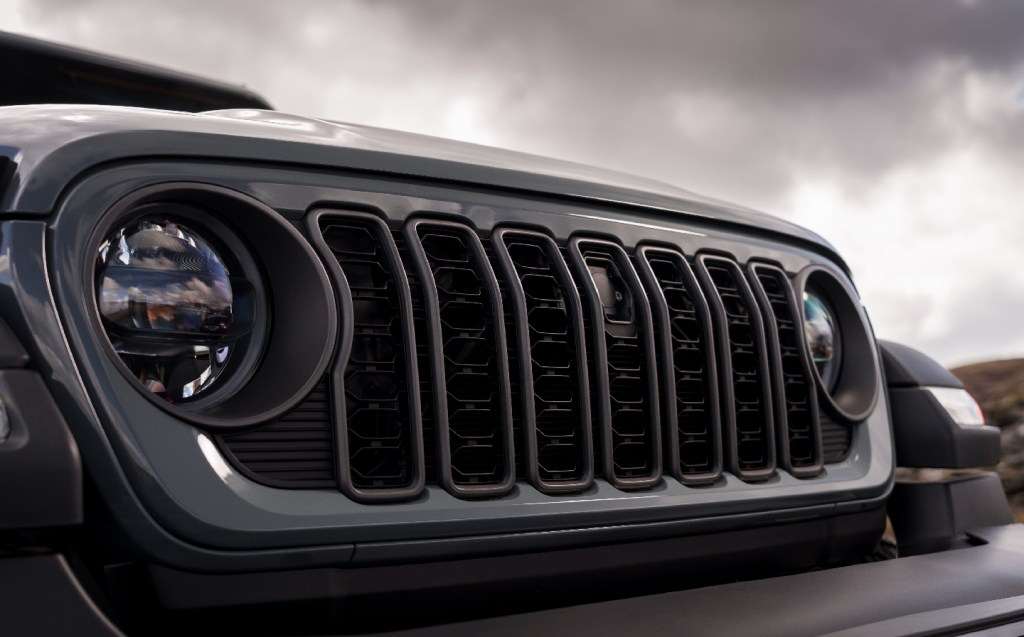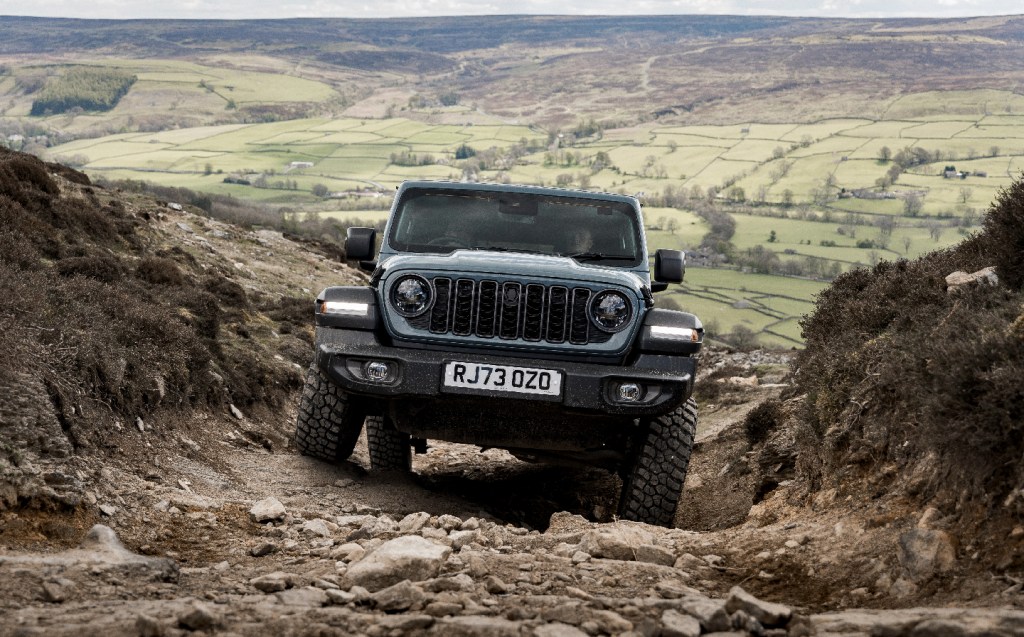Jeep Wrangler 2024 review: Impressive off road but you'd still have to be a committed contrarian to buy one
A rock star that most 4x4 fans will steer clear of
Years ago, before I knew better, I got into trouble with the Jeep PR people for publishing a story in which a 4×4 — described as a Jeep in other reports — had been involved in a nasty road traffic accident. The problem was that it wasn’t a Jeep at all, it was a Suzuki Jimny. Lesson learnt… don’t expect non-motoring journalists to know the difference.
People are still making this mistake. Anyone who watched the first series of The Traitors will have heard Claudia Winkleman refer to the fleet of old-style Land Rover Defender 130s, used to ferry about the contestants, as “Jeeps”. Not once, but on several occasions.
This is a double-edged sword for Jeep itself. On the one hand it means that the term “jeep” is synonymous with what most people think of as the definitive uncompromising off-roader; on the other, it means people say they want to buy a Jeep and then walk into a Land Rover dealer instead.
Which invariably, people in the UK are more likely to do — in the last financial year Land Rover sold more than 16,000 Defenders over here, while Jeep averages around 400 (yes, four hundred) Wrangler sales every 12 months.

It’ll be hoping to boost that considerably with the new model you can see here. The 2024 Jeep Wrangler is a significant update of the fifth generation model that was launched in 2018, but its distinctive look has clear roots that stretch back to the legendary Willys Jeep used by the American armed forces during WWII. The model refresh brings more tech, more comfort, more refinement and even more off-road capability — including trick new suspension for Rubicon versions — to the model.
It also brings a pricetag that starts at £61,125 for the entry-level Sahara and rises to upwards of £63,125 for the tougher Rubicons, which is most definitely punchy when you consider a four-door Defender costs from £60,470. Can the Jeep really be worth it?
Let’s start with the aesthetic updates. The Wrangler retains its distinctive two-box bodyshape, which most children would put to paper if asked to draw a 4×4. There are subtle changes, though, including a new grille, still with seven slots but now with a black texture and grey metallic bezels, plus a body-coloured surround.

Jeep has also done away with the steel mast antenna, replacing it with one that’s integrated into the windscreen, which makes a whole lot of sense given the likelihood that Wranglers will be sent down tight paths with overhanging rocks and branches. It also gets four new wheel designs (17-20in) and a new shade of paint.
But other than that, it’s business as usual with square windows, squared-off wheelarches and exposed hinges, suggesting a vehicle that’s more durable and easily repairable than the now-chic Defender. You can still also choose a variety of removable hardtop roof configurations, creating an open-top 4×4 with exposed roll cages. It’s either practical or butch, depending on how you look at it; I can’t help getting the image of Derek Zoolander and his model pals cruising through New York in their open-top 4×4 in my head… even though they were in a Ford Bronco, which rather proves my earlier point.
Tech upgrades include the latest 12.3in Uconnect 5 touchscreen infotainment system, which runs Apple CarPlay and Android Auto wirelessly, can connect two phones simultaneously via Bluetooth, and features over-the-air updates. Powered, heated front seats, reversing camera with front and rear sensors, and side curtain airbags are also standard fitments. All Wranglers also now comes with lane departure warning, drowsy driver alerts and traffic sign recognition.



More important for Wrangler customers will be its capabilities off the beaten track, and there’s good news there, as our test drive showed it has remarkable prowess off-road, even with road tyres and in Sahara form. The hardy body-on-frame structure remains, with liberal use of aluminium to help reduce weight. Under the body you’ll find Dana solid front and rear axles, high and low-range transmission, electronic traction control, tow hooks and four skid plates to protect the vital components.
If you buy the Rubicon version there’s also an upgraded Rock-Trac part-time transfer case with 4:1 low ratio (2.72:1 in the Sahara), front and rear locking diffs, electronic front anti-roll bar (Jeep insists on calling them sway bars) disconnnect and 17in BF Goodrich mud tyres.

What’s more, the Rubicon now gets a Dana 44 HD “full float” solid rear axle, which basically means the weight of the vehicle is suspended on a wheel hub connected to an axle tube, inside which the axle shaft itself spins. That means the axles shaft’s sole job is to transfer engine torque to the wheel, rather than having to deal with any other loads and forces, and this should make it more robust.
Speaking of engine torque, under the bonnet remains Jeep’s 2-litre turbocharged four-cylinder engine, with 268bhp and 295 lb ft of torque, and power is sent through an 8-speed auto ‘box. Off road it’s more than adequate but on the road it feels more gutless than the 7.6-second 0-62mph time would suggest.

What’s more, out of the box the Wrangler falls short compared with the Defender on all the vital 4×4 stats. Its approach, breakover and departure angles are 36.6, 21.4 and 31.8 degrees respectively, which compares with the Defender’s of 38, 28 and 40 degrees. The Wrangler’s wading depth also isn’t as impressive, as 760mm (900mm for the Defender).
It’s fair to say that none of this had any impact on the tough green lanes we showed the Wranglers in the Yorkshire Dales, which included some pretty steep rock inclines and a couple of water splashes; all were brushed off without the cars breaking a sweat, even on budget road tyres fitted to the Sahara. But if ultimate off-road Top Trumps is your thing, it’s something that needs saying.

Which would be fine if the Wrangler offered a more pleasing all-round driving experience, but the Defender has it licked here, too. The Jeep may be a lot more refined than before but it’s still lacking in road manners compared with the new Defender, with more wind noise (particularly around the roof panel joins) and a choppier ride. Both versions of the Wrangler suffer from lateral shimmy, which is even more noticeable on the Rubicon due to the knobbly tyres. The steering is rather poor, too, with a lot of movement around the centre before it turns; it’s the opposite of what other motoring hacks might call “direct”.
More frustratingly — and probably a deal-breaker for me — there’s nowhere to rest your left foot due to the bulky front transfer case sitting to the right of centre in the chassis. That led to cramps in my left leg on longer road stints.

All of which means that, while the Jeep Wrangler is undoubtedly an extremely capable off-roader, and better than before in many ways, it still remains the leftfield choice when it comes to full fat 4x4s. The Land Rover Defender is more accomplished off-road (on paper) and much more pleasing to drive on the black top.
Admittedly, the Wrangler’s shortfalls could sometimes be described as added character, when the Defender is now so polished and arguably increasingly sanitised. And in theory the Jeep should be easier to maintain. But with a £61k-plus asking price there’s only one sensible choice: buy the “jeep” that isn’t a Jeep, it’s a Land Rover.
Related articles
- If you were interested in this 2024 Jeep Wrangler review, you might like to check out what Will had to say about the 2020 Land Rover Defender
- Check out our review of the Jeep Avenger e-Hybrid 2024, too
- And don’t miss our Jeep Grand Cherokee 2024 review: Homing in on the Range Rover Sport
Latest articles
- Five best electric cars to buy in 2025
- Should I buy a diesel car in 2025?
- F1 2025 calendar and race reports: The new Formula One season as it happens
- Zeekr 7X AWD 2025 review: A fast, spacious and high tech premium SUV — but someone call the chassis chief
- Denza Z9GT 2025 review: Flawed but sleek 1,062bhp shooting brake from BYD’s luxury arm
- Extended test: 2024 Renault Scenic E-Tech review
- Best-selling cars 2025: The UK’s ten most popular models of the year so far
- Audi A6 Avant 2025 review: Trusty executive estate ticks expected boxes, and there’s still a diesel option
- Keir Starmer eases pressure on carmakers to sell EVs in response to ‘global economic headwinds’
























